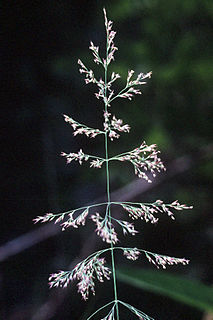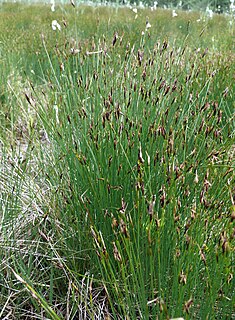
Smilax is a genus of about 300–350 species, found in the tropics and subtropics worldwide. In China for example about 80 are found, while there are 20 in North America north of Mexico. They are climbing flowering plants, many of which are woody and/or thorny, in the monocotyledon family Smilacaceae, native throughout the tropical and subtropical regions of the world. Common names include catbriers, greenbriers, prickly-ivys and smilaxes. Sarsaparilla is a name used specifically for the Jamaican S. ornata as well as a catch-all term in particular for American species. Occasionally, the non-woody species such as the smooth herbaceous greenbrier are separated as genus Nemexia; they are commonly known by the rather ambiguous name carrion flowers.

The Cyperaceae are a family of graminoid (grass-like), monocotyledonous flowering plants known as sedges. The family is large, with some 5,500 known species described in about 90 genera, the largest being the "true sedges" genus Carex with over 2,000 species.

Calamagrostis is a genus of flowering plants in the grass family Poaceae, with about 260 species that occur mainly in temperate regions of the globe. Towards equatorial latitudes, species of Calamagrostis generally occur at higher elevations. These tufted perennials usually have hairless narrow leaves. The ligules are usually blunt. The inflorescence forms a panicle. Some may be reed-like.

Schoenoplectus is a genus of plants in the sedges with a cosmopolitan distribution. Note that the name bulrush is also applied to species in the unrelated genus Typha as well as to other sedges. The genus Schoenoplectus was formerly considered part of Scirpus, but recent phylogenetic data shows that they are not closely related.

Helictotrichon, or alpine oatgrass, is a genus of perennial flowering plants in the grass family. The genus name comes from the Greek heliktos meaning twisted, and trichos meaning spine, referring to the shape of the awn.

Setaria is a widespread genus of plants in the grass family.

Eleocharis is a virtually cosmopolitan genus of 250 or more species of flowering plants in the sedge family, Cyperaceae. The name is derived from the Greek words ἕλειος (heleios), meaning "marsh dweller," and χάρις (charis), meaning "grace." Members of the genus are known commonly as spikerushes or spikesedges. The genus has a geographically cosmopolitan distribution, with centers of diversity in the Amazon Rainforest and adjacent eastern slopes of the South American Andes, northern Australia, eastern North America, California, Southern Africa, and subtropical Asia. The vast majority of Eleocharis species grow in aquatic or mesic habitats from sea level to higher than 5,000 meters in elevation.

Schoenus is a genus of sedges. Plants of this genus mainly occur in Australia and Southeast Asia with some species widespread in scattered locations in Europe, Asia, Africa, and the Americas. Bogrush is a common name for these plants.

Schoenoplectiella mucronata is a species of flowering plant in the sedge family known by the common names bog bulrush, rough-seed bulrush, and ricefield bulrush. It is native to Eurasia, Africa and Australia. It grows in moist and wet terrestrial habitat, and in shallow water. It is a perennial herb growing from a short, hard rhizome. The erect, three-angled stems grow in dense clumps and can reach a metre tall. The leaves take the form of sheaths wrapped around the base of stem, but they generally do not have blades. The inflorescence is a headlike cluster of cone-shaped spikelets accompanied by an angled, stiff bract which may look like a continuation of the stem.

Machaerina (twigrush) is a genus of flowering plants in the sedge family. Its species occur in tropical America, the West Indies, Malesia, Australia and the Pacific region. The name comes from the Greek machaira, alluding to the shape of the leaves in the type species – Machaerina restioides.

Fuirena, called umbrella sedges or umbrella grasses, are a genus of flowering plants in the sedge family (Cyperaceae), with a worldwide distribution, chiefly in the tropics and temperate zones. They are named for Danish physician and early botanist Georg Fuiren, 1581–1628.

Costularia is a plant genus in the family Cyperaceae. It includes four distinct lineages:
- Costularia s.s. from Africa, Madagascar, the Mascarene Islands and Seychelles.
- Chamaedendron Larridon from New Caledonia.
- a group largely conforming to subgenus, Lophoschoenus from New Caledonia and Malesia that are now considered to be part of a redelimited genus Tetraria, which are found on the island of Madagascar.
- the species Xyroschoenus hornei which is endemic to the Seychelles.












